
A bandura is a Ukrainian plucked-string folk-instrument. It combines elements of the zither and lute and, up until the 1940s, was also often called a kobza. Early instruments had 5 to 12 strings and resembled lutes. In the 20th century, the number of strings increased initially to 31 strings (1926), then to 56 strings – 68 strings on modern "concert" instruments (1954).

A kobzar was an itinerant Ukrainian bard who sang to his own accompaniment, played on a multistringed kobza or bandura.
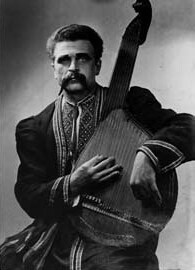
A bandurist is a person who plays the Ukrainian plucked string instrument known as the bandura.

Opanas Heorhiiovych Slastion was a Ukrainian graphic artist, painter, and ethnographer.

Hnat Martynovych Khotkevych was a Ukrainian theater and public figure, engineer, inventor, writer, historian, translator, ethnographer, art critic, playwright, screenwriter, composer, musicologist, violinist, pianist, baritone, bandurist, and teacher. He was shot by the KGB during the Great Terror in the Soviet Union.
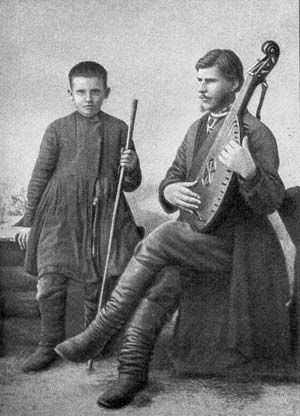
Ivan Iovych Kuchuhura-Kucherenko was a Ukrainian minstrel (kobzar) and one of the most influential kobzars of the early 20th century. For his artistry he was awarded the title "People's artist of Ukraine" in 1919 and later "People's Artist of the Ukrainian Soviet Socialist Republic" in 1926.
Kobzarskyi Tsekh, literally "Kobzar guild", is an organization of kobzars, which have existed since the 17th century in Ukraine.

Ostap Mykytovych Veresai was a renowned minstrel and kobzar from the Poltava Governorate of the Russian Empire. He helped to popularize kobzar art both within Ukraine and beyond. He is noted for influencing both scholarly and popular approaches to minstrelsy.
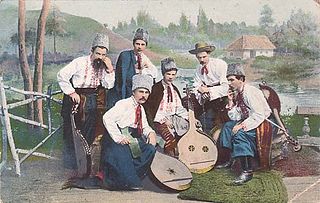
The Kyiv Bandurist Capella is a male vocal-instrumental ensemble that accompanies its singing with the playing of the multi-stringed Ukrainian folk instrument known as the bandura.
A series of Russian Archeological Congresses began in 1867. The aim of these conferences was to discuss and to make public studies dealing with matters of antiquity and ethnography. The Conferences were held in a different city every three years.
Kobzars and bandurists were a unique class of musicians in Ukraine, who travelled between towns and sang dumas, a meditative poem-song. Kobzars were usually blind, and required the completion of a three-year apprenticeship in specialized Kobzar guilds, in order to be officially recognized as such. In 1932, on the order of Stalin, the Soviet authorities called on all Ukrainian Kobzars to attend a congress in Kharkiv. Those that arrived were taken outside the city and were all put to death.
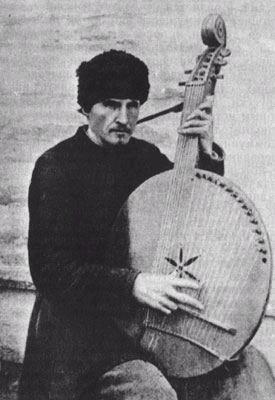
Terentiy (Tereshko) Makarovych Parkhomenko (1872–1910) was one of the most respected Ukrainian kobzars of the late 19th and early 20th century.

Hryhory Ivanovych Bazhul was a Ukrainian bandurist and publisher of articles on bandura history from Poltava, Russian Empire. After World War II he emigrated to Australia settling in Sydney.

Hnat Tykhonovych Honcharenko was one of the most renowned Ukrainian kobzars of the Kharkiv oblast of the late 19th and early 20th centuries.
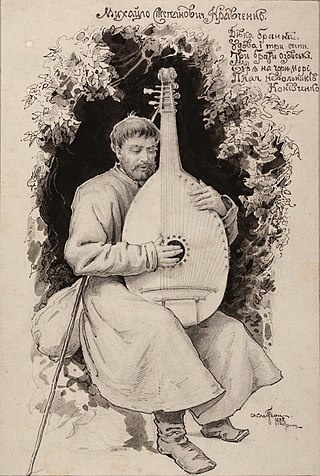
Mykhailo Stepanovych Kravchenko was regarded as one of the most outstanding kobzars of Poltava province of the late 19th early 20th century.

Vasyl' Potapenko (1886–1934) born in Berezna, Mensk region, Chernihiv province was the guide-boy for the blind kobzar Tereshko Parkhomenko. As a guide-boy he was a participant of the ХІІth Archeological congress held in Kharkiv in 1902. He travelled to Halychyna by himself after discovering that Hnat Khotkevych had invited kobzars to perform there in 1909. When he discovered that the audiences in Halychyna had expected blind bandurists, he tried to blind himself by spraying caustic soda in his eyes. He returned to central Ukraine settling in Kiev where he made a living teaching bandura and re-selling banduras. Many of his students joined the Kiev Bandurist Capella in its second incarnation from 1924. He was a participant at the Xth historic-ethnographic concert held in Kiev in 1928. On October 15, 1930 Potapenko was arrested for being a member of "counter-revolutionary" (anti-Soviet) organizations. There were further arrests ending in his unexplained disappearance.

Petro Semenovych Drevchenko (1863–1934), also known by the surname of Drevkin and Drygavka, was a Ukrainian kobzar.
A Kuban bandurists is a person who plays the Ukrainian plucked string instrument known as the bandura, who is from Kuban, a geographic region of southern Russia surrounding the Kuban River.
The XIIth Archeological Congress Kharkiv, 1902 was one of a number of Archeological Conferences known as Congresses held in Russian Empire. These Conferences were hosted by a different city of the Russian Empire every three years.

Zaporizhian March is an expressive Ukrainian folk musical art that was preserved and revived by bandurist Yevhen Adamtsevych. The march became more famous after its arrangement by Viktor Hutsal who merged the march with the folk song about Doroshenko and Sahaidachny.















